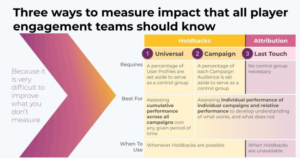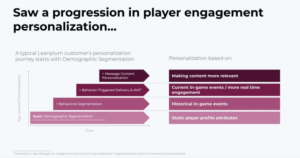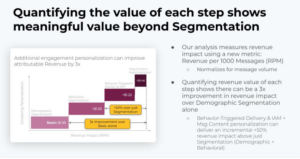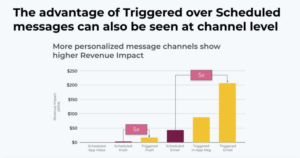There’s no denying that the mobile gaming market has been booming at an astonishing rate. Not only is there a very low barrier to entry to play mobile games, but the isolation brought on by COVID-19 has also made people much more dependent on gaming as a form of entertainment. Naturally, this growth brings with it a huge opportunity for mobile gaming apps to capitalize on in-game revenues.
At Leanplum, we have built a strong product for the mobile gaming market, and currently serve numerous global gaming customers, including some of the top 10 gaming studios in the world. Listening to our customers, we realized there were some universal questions that many of them wanted to get answered. We also noticed that while player engagement and player retention metrics are important to gaming studios, their ultimate goal is to drive revenue growth. With that in mind, we created our Inaugural Data Science Report for the Games App Category to analyze key campaign performance metrics and their impact on revenue.
The report was recently released, and we also discussed its findings with our customers and guest speakers in two global webinars, (EMEA, in collaboration with GameDuell and 2nd Potion, where our guests shared examples from their work on customer retention and monetization – watch on-demand and (North America, in collaboration with Tilting Point, where we discuss live ops best practices – watch on-demand.
Key Strategies to Increase Player Engagement and Revenue For Mobile Games
What Does the Data Reveal?
Our data science report is based on an analysis of over 1800 campaigns and more than 670M+ messages sent by our mobile gaming customers, the majority of which drive revenue through in-app purchases. The gaming categories we explored were: casino, card, puzzle, role playing, strategy, racing, and simulation.
The results of our analysis were eye-opening and should be used by product managers, marketers, and live ops teams to optimize player engagement and revenue. Below, we discuss some of our key findings.
Holdbacks Are Essential
One of our key findings is the value of holdbacks. While our report found that most of our customers don’t use holdbacks, holdbacks are key to your ultimate success. Campaign-level holdbacks are essential for measuring the impact of individual campaigns and comparing different campaign results. Universal holdbacks, on the other hand, require that you suppress a bucket of your users from receiving any messages from you. While more expensive to implement, universal holdbacks are super helpful in calculating the long-term value of all your campaigns. In the event that neither universal nor campaign-level holdbacks are possible, LTA (Last Touch Attribution) may be used to measure revenue impact.
Figure 1 – Holdbacks and when to use them
Use a Personalization Ladder
In analyzing our data, we noticed a direct link between incremental revenue and personalization. Also, we’ve created a personalization ladder (Figure 2) which reflects the pattern of progressive personalization methods we found.
At the very base of the ladder is basic personalization or demographic segmentation of your audience, which is based on static user attributes (we track over 2000 user attributes). The next level up is adding behavioral segmentation, which looks at historical in-game events. This is also where Leanplum has done a lot of work with our new Recency and Frequency feature, which allows you to look at events and event parameters and even aggregate functions, such as total sum, average, and mid and max values of total spend.
From there, we move up to behavior-triggered plus IAM (in-app messaging), where you’re using real-time player behavior and player journeys to trigger appropriate messaging. And, finally, at the very top of the ladder, we get to message personalization, where we offer support for:
- Jinja, a flexible web template engine for the Python programming language, which, among other things, enables useful conditional loops
- Linked Data for flexibility to customize messages at send-time with data or content which resides outside of Leanplum (e.g. an internal recommendation engine).
Our data science report showed that less than 10% of messages sent used the two personalization methods at the top of the ladder (behavior triggered+IAM, and message content personalization), while over 50% used basic segmentation.
Figure 2 – Personalization ladder
The good news here is that there is a lot of room to grow and add deeper personalization.
How Does This All Come Together?
To show the impact of our personalization ladder on revenue, we used a metric called RPM (revenue per thousand messages). Figure 3 shows that as we climb up the ladder and offer deeper personalization, we see a direct impact on revenue. Ultimately, as we climb the ladder and get to the very top, there is a 3X impact on revenue over personalization with just basic segmentation.
Figure 3 – Relationship between personalization and revenue
We also found support for greater revenue impact by comparing RPM by messaging channels. Here, triggered delivery (push and email) outperformed scheduled delivery by 5X.
Recommendations and Next Steps
While we can’t cover all the findings from our Data Science Report and webinar discussions in a blog post, we’d like to leave product managers, marketers, and live ops teams at gaming studios with key next steps that they should consider and implement immediately.
- Use Holdbacks to Measure Campaign Goals with Higher Confidence
Universal holdbacks are best for measuring the performance of your campaigns over a period of time – monthly or quarterly – to assess overall performance. Campaign-level holdbacks are your ally when it comes to comparing performance between campaigns to understand what’s working and what’s not. While there is an opportunity cost to using Holdbacks, it is very difficult for studios to optimize what they can’t measure with confidence.
- Further Personalize for Better Player Engagement
Keep our personalization ladder in mind as you think about your messaging strategy. Remember as you move up from basic demographic segmentation all the way to message content personalization, you’ll realize a direct positive impact on revenue.
- Be Mindful of Delivery Channels
No matter what delivery channel you use, push, in-app or email, the better targeted your messages, the higher the impact on revenue.
To learn more about what Leanplum can do for your team, check out these resources:
- For a quick overview, watch our 2-minute Gaming video
- We are the only engagement platform with a focus on Gaming
- Watch the full webinar with MobilityWare, LiveOps on a Shoestring Budget, where we discuss the inner workings of how they use Leanplum for live events
- Explore our Games Data Science Report to see how specific engagement strategies impact retention and revenue
- Read our article on Mobile Gaming 2021: How to Increase Player Engagement and Revenue for more insights on boosting overall engagement and monetization in mobile gaming
- Check out the Product Tour to see Leanplum in action
- Set up a complimentary personalized demo of Leanplum
—
For app-first companies, Leanplum is the only solution that helps personalize and optimize all customer touchpoints, both inside and outside the app. Leanplum combines multi-channel Lifecycle Marketing with the ability to A/B test the Product Experience for complete, end-to-end personalization of the mobile journey. Break down organizational silos and eliminate point solutions to enable rapid growth.








